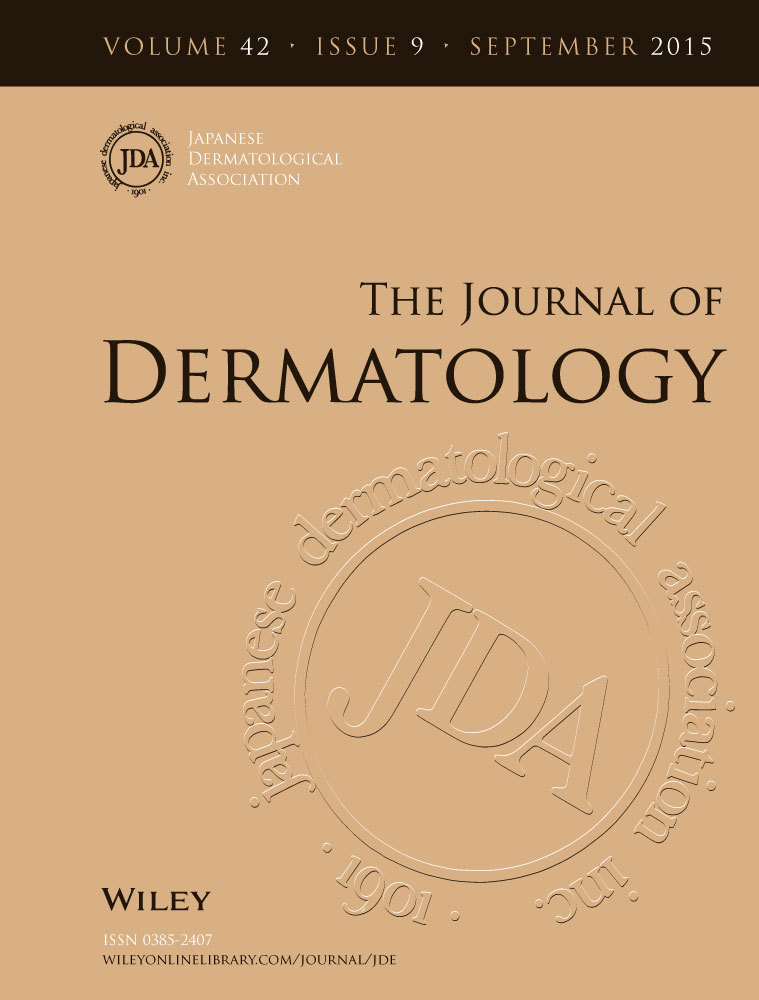Case of Hermansky–Pudlak syndrome 1 in a Japanese infant
Mari Tanaka
Department of Dermatology, Osaka University Graduate School of Medicine, Osaka, Japan
These authors contributed equally to this study.Search for more papers by this authorLiping Yang
Department of Dermatology, Osaka University Graduate School of Medicine, Osaka, Japan
These authors contributed equally to this study.Search for more papers by this authorCorresponding Author
Mari Wataya-Kaneda
Department of Dermatology, Osaka University Graduate School of Medicine, Osaka, Japan
Correspondence: Mari Wataya-Kaneda, M.D., Ph.D., Department of Dermatology, Osaka University Graduate School of Medicine, 2-2 Yamadaoka, Suita, Osaka 565-0871, Japan. Email: [email protected]Search for more papers by this authorTamio Suzuki
Department of Dermatology, Faculty of Medicine, Yamagata University, Yamagata, Japan
Search for more papers by this authorKen Okamura
Department of Dermatology, Faculty of Medicine, Yamagata University, Yamagata, Japan
Search for more papers by this authorYutaka Hozumi
Department of Dermatology, Faculty of Medicine, Yamagata University, Yamagata, Japan
Search for more papers by this authorFei Yang
Department of Dermatology, Osaka University Graduate School of Medicine, Osaka, Japan
Search for more papers by this authorIchiro Katayama
Department of Dermatology, Osaka University Graduate School of Medicine, Osaka, Japan
Search for more papers by this authorMari Tanaka
Department of Dermatology, Osaka University Graduate School of Medicine, Osaka, Japan
These authors contributed equally to this study.Search for more papers by this authorLiping Yang
Department of Dermatology, Osaka University Graduate School of Medicine, Osaka, Japan
These authors contributed equally to this study.Search for more papers by this authorCorresponding Author
Mari Wataya-Kaneda
Department of Dermatology, Osaka University Graduate School of Medicine, Osaka, Japan
Correspondence: Mari Wataya-Kaneda, M.D., Ph.D., Department of Dermatology, Osaka University Graduate School of Medicine, 2-2 Yamadaoka, Suita, Osaka 565-0871, Japan. Email: [email protected]Search for more papers by this authorTamio Suzuki
Department of Dermatology, Faculty of Medicine, Yamagata University, Yamagata, Japan
Search for more papers by this authorKen Okamura
Department of Dermatology, Faculty of Medicine, Yamagata University, Yamagata, Japan
Search for more papers by this authorYutaka Hozumi
Department of Dermatology, Faculty of Medicine, Yamagata University, Yamagata, Japan
Search for more papers by this authorFei Yang
Department of Dermatology, Osaka University Graduate School of Medicine, Osaka, Japan
Search for more papers by this authorIchiro Katayama
Department of Dermatology, Osaka University Graduate School of Medicine, Osaka, Japan
Search for more papers by this author
References
- 1Okamura K, Yoshizawa J, Abe Y et al. Oculocutaneous albinism (OCA) in Japanese patients: five novel mutations. J Dermatol Sci 2014; 74: 173–174.
- 2Cullinane AR, Curry JA, Carmona-Rivera C et al. A BLOC-1 mutation screen reveals that PLDN is mutated in Hermansky-Pudlak Syndrome type 9. Am J Hum Genet 2011; 88: 778–787.
- 3Nazarian R, Falcon-Perez JM, Dell'Angelica EC. Biogenesis of lysosome-related organelles complex 3 (BLOC-3): a complex containing the Hermansky-Pudlak syndrome (HPS) proteins HPS1 and HPS4. Proc Natl Acad Sci USA 2003; 100: 8770–8775.
- 4Suzuki T, Ito S, Inagaki K et al. Investigation on the IVS5 + 5G –> a splice site mutation of HPS1 gene found in Japanese patients with Hermansky-Pudlak syndrome. J Dermatol Sci 2004; 36: 106–108.
- 5Natsuga K, Akiyama M, Shimizu T et al. Ultrastructural features of trafficking defects are pronounced in melanocytic nevus in Hermansky-Pudlak syndrome type 1. J Invest Dermatol 2005; 125: 154–158.




